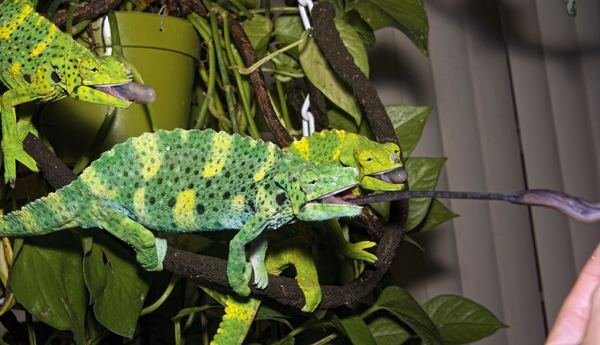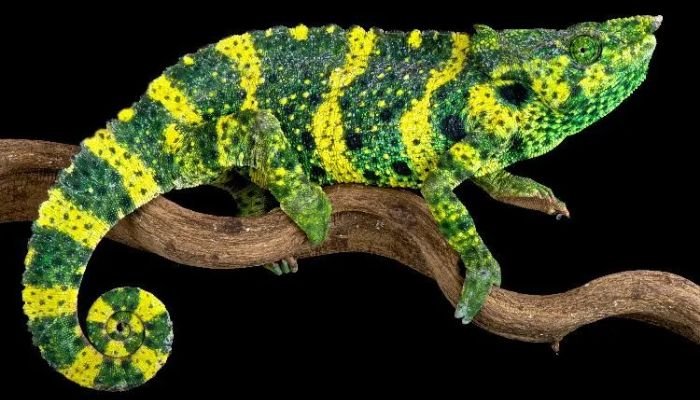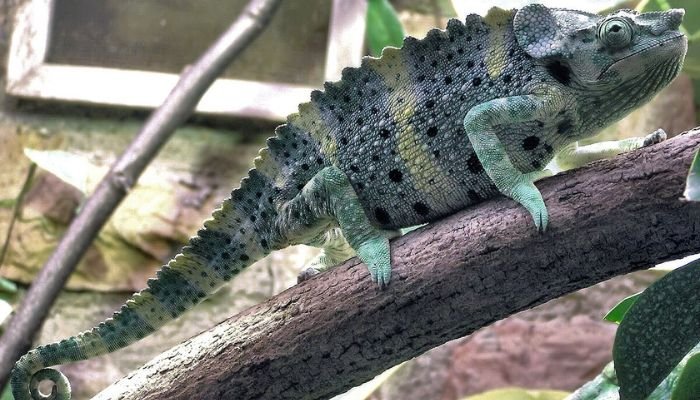
The fascinating Meller’s Chameleon is a species of reptile found in Eastern Africa. The Meller’s Chameleon is highly esteemed by herpetologists for its extraordinary size and stunning coloration. It has pupils that move independently, a prehensile tail, and the ability to change color. Their principal habitat is montane forests, and the majority of their diet consists of insects and plants. In order for these chameleons to thrive in captivity, appropriate care and habitat replication are essential.. Here are Meller’s chameleon Guide on Food, Habitat, Size, Lifespan & Predators below-
Meller’s chameleon Stats in Table format
The stats are given below for Meller’s chameleon
| Reptiles List | Meller’s chameleon |
|---|---|
| Family | Chamaeleonidae |
| Type | Lizard |
| Size | Medium |
| Length | Meller’s chameleon: Up to 16-20 inches (40-50 cm) |
| Color | Meller’s chameleon: The color varies depending on the species, but Meller’s chameleons can have shades of green, brown, or yellow, often with patterns or markings. |
| Weight | Meller’s chameleon: Adult Meller’s chameleons can weigh between 1 to 2 pounds.. |
| Lifespan | 5-10 years (or more) |
| Reproduction | Oviparous, lays eggs |
| Gestation Periods | Approximately 4-6 months |
| Endangered Status | Not Evaluated (IUCN Red List) |
| Features | Color-changing ability, independently moving eyes |
| Country & Areas | Madagascar |
Meller’s Chameleon Natural Habitat and Distribution
Eastern and southern Africa are home to Meller’s chameleon (Trioceros melleri), also known as the huge one-horned chameleon. Its native habitat consists of a wide variety of ecosystems, from tropical forests to dry grasslands. Tanzania, Malawi, Mozambique, and Zambia are major hotspots for the spread of these reptiles. They prefer habitats with a medium amount of vegetation and a wide variety of plant life, as this provides them with ample cover and food sources.
Meller’s Chameleon Physical Features and Adaptations
Here are some information about Meller’s Chameleon Physical Features and Adaptations
1. Body Structure
Meller’s chameleons are easily distinguishable from other reptiles due to their unique body form. Their huge triangular heads and freely moving eyes give them pinpointed vision for scanning their environments. Their long, lean bodies are built for climbing, and their strong, prehensile arms are built for grabbing hold of tree trunks and limbs. Zygodactylous feet, with two forward and two backward pointed toes, are an advantageous adaptation for an arboreal lifestyle.
2. Coloration and Patterns
The capacity to change color is one of the most impressive characteristics of Meller’s chameleons. The chromatophores in their skin allow them to show off an incredible spectrum of colors and patterns. Thermoregulation, concealment, and communication are just a few of the many benefits of these chromatic shifts. Meller’s chameleons may change their color to reflect their mood or communicate with others.
3. Defense Mechanisms
To stave off predators, Meller’s chameleons have developed a number of defensive systems. They may hiss and puff up their bodies to look bigger when they feel threatened. In addition, their ability to change color makes it more difficult for predators to locate them. Their freely spinning eyeballs provide them a 360-degree field of vision, allowing them to spot danger from any angle.

Meller’s Chameleon Diet and Feeding Habits
Here are some information about Meller’s Chameleon Diet and Feeding Habits
1. Diet Type
Meller’s chameleons eat both plants and small animals, making them omnivores. They are able to thrive in their environments by eating a wide variety of foods because of this.
2. Preferred Food Sources
Insects like crickets, grasshoppers, and worms make up the bulk of their food. They also occasionally consume lizards and other small vertebrates, including birds. Leaves, flowers, and fruits provide Meller’s chameleons with the water and nutrients they need, in addition to animal waste.
3. Feeding Schedule
As opportunistic feeders, Meller’s chameleons may alter their feeding schedule in response to changes in their environment or the availability of food. They are fed twice a day in captivity to maintain a healthy and well-balanced diet.
Meller’s Chameleon Housing and Enclosure Requirements
Here are some information about Meller’s Chameleon Housing and Enclosure Requirements
1. Terrarium Size and Setup
An appropriate-sized terrarium is essential for captive Meller’s chameleons. Because of their arboreal habits, their enclosure needs to be high and slanted so they have plenty of places to climb and perch. Adult chameleons should have at least four feet of vertical space in their terrarium. There should be plenty of branches and foliage to make it look like their natural habitat and provide them somewhere to hide.
2. Substrate Options
A substrate that helps keep the chameleon’s enclosure clean and moist is ideal for Meller’s chameleons. To keep the chameleon comfortable and allow for digging and burrowing, a substrate of organic soil, coconut coir, and sphagnum moss is recommended.
3. Temperature and Lighting
For Meller’s chameleons, a proper temperature gradient is crucial for efficient thermoregulation. The warmer side of the enclosure should be maintained around 90–95 degrees Fahrenheit (32–35 degrees Celsius), while the cooler side can be maintained at 75–80 degrees Fahrenheit (24–27 degrees Celsius). Calcium metabolism and metabolic bone disease can be avoided with adequate UVB lighting.

4. Humidity and Water Needs
The ideal humidity for Meller’s chameleons is between 50 and 70%. This can be accomplished by constantly spraying the enclosure with water, particularly during warmer times of the year. The chameleons can drink and stay hydrated if you provide a dripper or a shallow water dish.
Meller’s Chameleon Behaviour and Temperament
Here are some information about Meller’s Chameleon Behaviour and Temperament
1. Activity Levels
The diurnal lifestyle of Meller’s chameleons means that they are most active during daylight hours. They invest a considerable amount of time both sunning and searching for food. Because of their arboreal make-up, they gravitate for vertical environments.
2. Social Behaviour
Meller’s chameleons are often solitary and territorial in the wild. They like to spend their time alone and only gather for mating season.
3. Handling and Taming
Meller’s chameleons have a poor reputation for being handled. Excessive handling, which might cause them stress, should be avoided. The reptile should be handled softly and with as little interaction as possible to reduce the likelihood of stress.
Meller’s Chameleon Breeding and Reproduction
Here are some information about Meller’s Chameleon Breeding and Reproduction
1. Mating and Courtship Rituals
Male Meller’s chameleons perform intricate courtship rituals and change their appearance dramatically during breeding season. Some of the behaviors used in these rituals to attract a partner include bobbing of the head, posture taking, and pattern flaunting.
2. Incubation and Hatchlings
The female will lay her eggs in the ground or substrate after a successful mating. The eggs must be incubated for a number of months before they are ready to hatch. The moment they emerge from their eggs, the hatchlings are completely on their own.
Meller’s Chameleon Common Health Issues and Veterinary Care
Here are some information about Meller’s Chameleon Common Health Issues and Veterinary Care:-
1. Respiratory Infections
If the chameleon’s enclosure has poor ventilation or the humidity is regularly too high, respiratory illnesses may develop. Breathing difficulties, wheezing, and fatigue are all signs of this condition. Rapid veterinary attention is required if your pet exhibits any symptoms of breathing problems.
2. Parasites
Meller’s chameleons are susceptible to internal and external parasites if they are fed contaminated food or kept in a dirty environment. They need to have their feces checked for parasites on a regular basis.
3. Metabolic Bone Disease
Reptiles often suffer from metabolic bone disease due to an inadequate intake of calcium and too much phosphorus. Bones become fragile, and sometimes even deformed, as a result. The condition can be avoided by providing adequate UVB lighting and a healthy diet.

Importance of Regular Vet Check-ups
It is crucial that captive Meller’s chameleons receive routine veterinarian care. A trained reptile vet can check for any potential health problems, propose a diet that will keep your pet happy and healthy, and handle any emergencies that may arise. The chameleon’s overall health and the likelihood of a successful therapy are greatly improved if problems are identified early.
Conclusion
The fascinating Meller’s chameleon is a type of lizard that has adapted to a wide range of environments in Africa. Researchers and aficionados of reptiles alike have always been fascinated by these animals due to the unique traits they’ve evolved, such as the ability to change color and eyeballs that can rotate independently. Those who seek to keep Meller’s chameleons in captivity must provide the best possible care and husbandry for the animals to ensure their health, well-being, and longevity.
FAQS
Q: What is the family and Type of a Meller’s chameleon?
A: The Meller’s chameleon is a species of family Chamaeleonidae. The Famous Meller’s chameleon is a member of the family Lizard.
Q: What is the average size of a Meller’s chameleon?
A: The average adult Meller’s chameleon is Medium between Meller’s chameleon: Up to 16-20 inches (40-50 cm).
Q: How long can a Meller’s chameleon grow in size in lengths?
A: Meller’s chameleon is Medium in size and The Meller’s chameleon can grow up to an impressive length of 16-20 inches (40-50 cm).
Q: What colors do Meller’s chameleon come in?
The capacity to change hues is what makes Meller’s chameleon such an interesting animal. Depending on the species, these chameleons can be a variety of colors, although green, brown, and yellow are the most prevalent. Intricate marks or patterns can also be seen on their bodies.
Q: How big can a Meller’s chameleon get in weight?
In addition to its common name, Meller’s chameleon is also known as the Giant one-horned chameleon. These chameleons can reach a hefty adult weight of up to 2 pounds when they reach maturity.
Q: What are the special Features of a Meller’s chameleon?
A: Meller’s chameleon is a Color-changing ability, independently moving eyes
Q: How long do Meller’s chameleon live?
A: The usual lifespan of a Meller’s chameleon is The Meller’s chameleon has a lifespan of approximately 5-10 years, although some individuals may live even longer.
Q: What food does the Meller’s chameleon eat?
Answer: The Meller’s chameleon prefers insects like crickets, grasshoppers, and beetles for its main source of nutrition. They also eat lizards, birds, and other small vertebrates. Plant materials like leaves and flowers round up their diet. They capture their prey with a long, sticky tongue. Meller’s chameleons need a wide variety of foods to get the vitamins and minerals they need to thrive.
Q: What is the best habitat for a Meller’s chameleon?
The warm, moist environment of a tropical jungle is ideal for Meller’s chameleons. These chameleons are native to the eastern coast of Africa, therefore the rich vegetation and high humidity of the rainforest are perfect for them. They require a diversified food and an environment rich in tree and plant species for climbing and hiding. Temperatures between 75 and 85 degrees Fahrenheit and relative humidity between 60 and 80% are perfect for them. Clean water for drinking and misting, as well as ultraviolet B lighting, are necessities. In general, Meller’s chameleons can only survive in carefully maintained replicas of tropical rainforests with the ideal temperature, humidity, and plant life.
Q: How do Meller’s chameleon give birth?
A: Meller’s chameleon are Oviparous, lays eggs
Q: How long is the gestation period for a Meller’s chameleon?
A: The gestation period of a Meller’s chameleon is approximately Approximately 4-6 months
Q: What is the natural behavior of a Meller’s chameleon?
The bulk of chameleons in Meller’s collection are Meller’s chameleons are naturally arboreal, meaning they prefer to spend most of their time up in the branches of trees. The ability to change hue allows it to better conceal itself and evade predators by hiding in plain sight. The long, sticky tongue of a Meller’s chameleon is one of its most distinctive features, and it is used for catching insects. Except during breeding season, this animal is usually spotted on its own. Males have a natural instinct to protect their turf from other males. They nod their heads and change hue as a kind of nonverbal communication. In general, Meller’s chameleon is an interesting reptile because of the unusual ways it adapts to its environment.
Q: Is the Meller’s chameleon endangered?
A: The Meller’s chameleon is Not Evaluated (IUCN Red List).
Q: What are the prey of Meller’s chameleon?
Insects like crickets, grasshoppers, and beetles are typical fare for Meller’s chameleon. They also prey on lizards, tiny birds, and other vertebrates. Ambush predators like the Meller’s chameleon use their long tongues to seize their prey. Their eyesight is so good that they can identify prey from great distances. Live prey, which is captured with a swift and precise tongue strike, makes up the bulk of their food.
Q: Do Meller’s chameleon have any Predators?
The chameleons of Meller’s genus Birds of prey like hawks and owls, snakes, and small mammals like rats and mongooses are all potential threats to Meller’s chameleons. The chameleon is an easy target for these animals due to its vivid colors and lethargic mobility. Humans also endanger Meller’s chameleons by destroying their environment and by illegally trading them as pets.
Q: How Fast Does Meller’s Chameleon Move?
A: Meller’s chameleon can move at speeds of up to 0.6 meters per second.
Q. What is Bite Force of Meller’s chameleon in PSI?
A. Bite Force in PSI is a measure of the strength of a chameleon’s bite, typically around 30-40 PSI.
Q: Can we keep Meller’s chameleon as pets?
The chameleon known as Meller’s can be tamed and made into a pet. They can change their skin color and are recognized for their vivid hues. However, they can thrive in captivity with the right attention and environment. To preserve their health as pets, it is essential to learn about their requirements and to provide for their care.
I hope you like reading on Meller’s chameleon FAQ Guide on Food, Habitat, Size, Lifespan and Predators.
